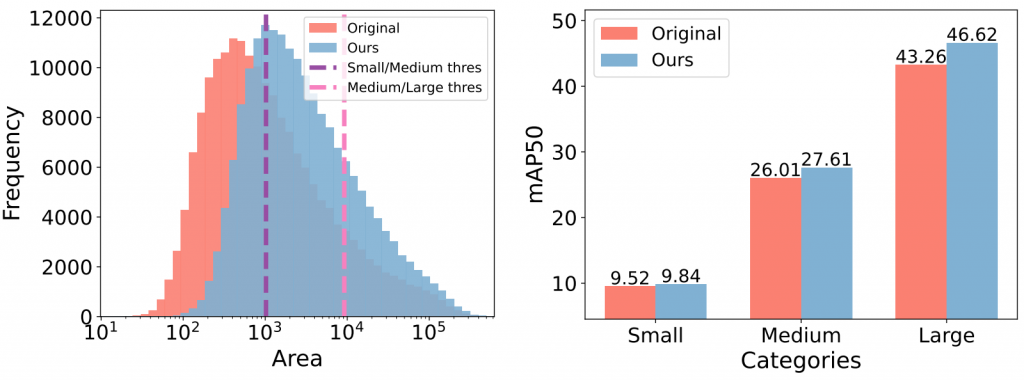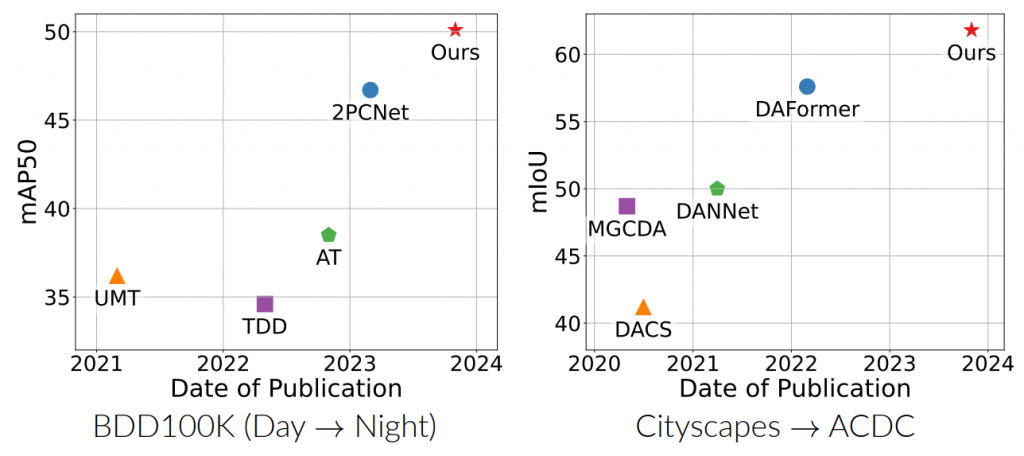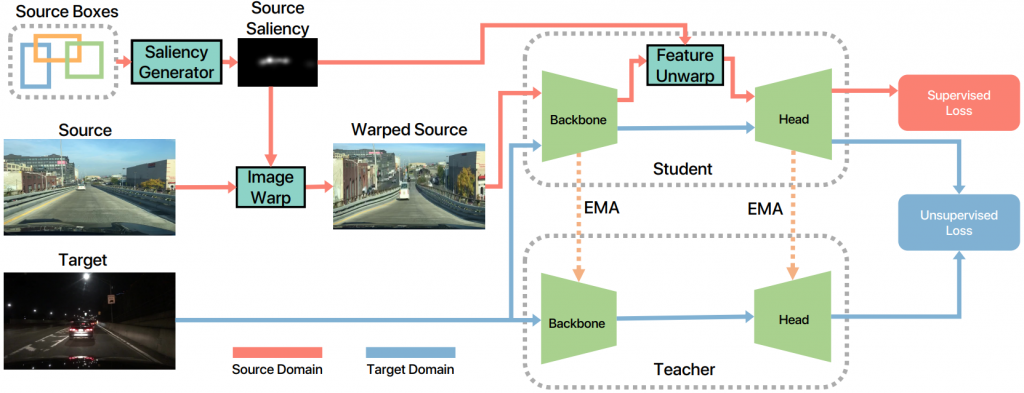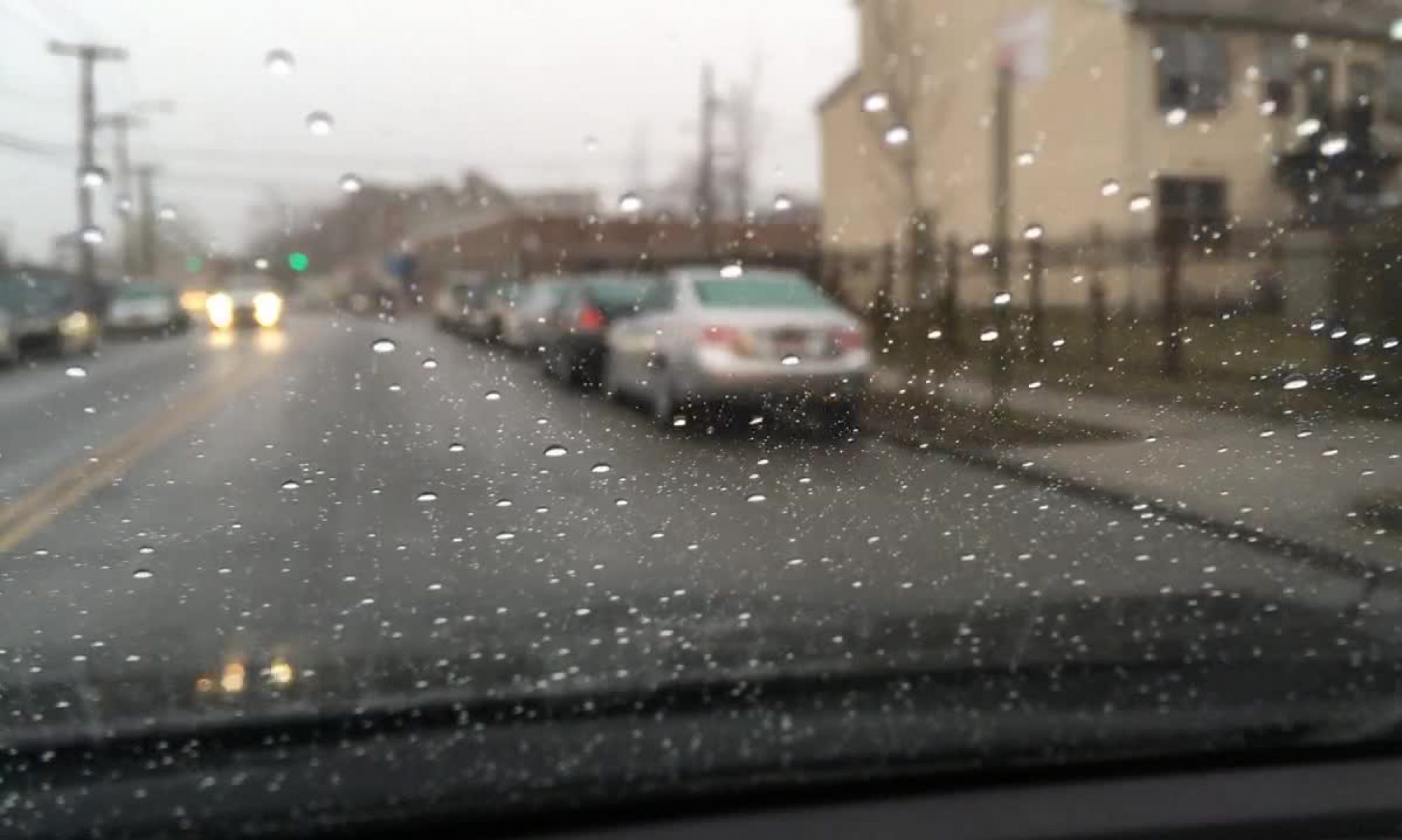In this page, we briefly introduce our work in Fall 2023.
Title:
Instance-level image warping for domain adaptation
Links:
Contributions:
- Introduce a Instance-Level Image Warping to address scale bias in driving.
- Incorporate image warping and feature unwarping into domain adaptation.
- Task-agnostic and plug-and-play during training; no warping during testing.
Motivation
Non-uniform Instance-level Image Warp. Bounding boxes mark small (red), medium (green) and large (blue) objects in the image. Object Scale bias challenges contemporal visual recognition systems, whereas our instance-level image warping oversample the medium and large objects to effectively addressing that object scale bias.

Object Size Distribution Shift and AP Improvement
Left: Shifting the distribution rightward, we reduce # of small objects while increasing # of medium and large objects. Right: Fewer small objects has minimal impacts, whereas more medium and large object brings significant improvements.

State-of-the-Art Performances

Workflow
Instance-level Image Warping for Domain Adaptation. For the source domain stage, we generate a saliency map based on source bounding bboxes and unwarp the features before computing the supervised loss. For the target domain stage, we do not use warp or unwarp.

Mathematical Details

Supervised Semantic Segmentation (Cityscapes)


Domain Adaptive Semantic Segmentation (Cityscapes -> ACDC)


Domain Adaptive Object Detection (BDD100k day -> night)


Referneces
[1] Kennerley, Mikhail, et al. “2PCNet: Two-Phase Consistency Training for Day-to-Night Unsupervised Domain Adaptive Object Detection.” Proceedings of the IEEE/CVF Conference on Computer Vision and Pattern Recognition. 2023.
[2] Hoyer, Lukas, Dengxin Dai, and Luc Van Gool. “Daformer: Improving network architectures and training strategies for domain-adaptive semantic segmentation.” Proceedings of the IEEE/CVF Conference on Computer Vision and Pattern Recognition. 2022.
[3] Xie, Enze, et al. “SegFormer: Simple and efficient design for semantic segmentation with transformers.” Advances in Neural Information Processing Systems 34 (2021): 12077-12090.
[4] Cordts, Marius, et al. “The cityscapes dataset for semantic urban scene understanding.” Proceedings of the IEEE conference on computer vision and pattern recognition. 2016.
[5] Sakaridis, Christos, Dengxin Dai, and Luc Van Gool. “ACDC: The adverse conditions dataset with correspondences for semantic driving scene understanding.” Proceedings of the IEEE/CVF International Conference on Computer Vision. 2021.
[6] Sakaridis, Christos, Dengxin Dai, and Luc Van Gool. “Guided curriculum model adaptation and uncertainty-aware evaluation for semantic nighttime image segmentation.” Proceedings of the IEEE/CVF International Conference on Computer Vision. 2019.
[7] Thavamani, Chittesh, et al. “Fovea: Foveated image magnification for autonomous navigation.” Proceedings of the IEEE/CVF international conference on computer vision. 2021.
[8] Ghosh, Anurag, et al. “Learned Two-Plane Perspective Prior based Image Resampling for Efficient Object Detection.” Proceedings of the IEEE/CVF Conference on Computer Vision and Pattern Recognition. 2023.
[9] Thavamani, Chittesh, et al. “Learning to Zoom and Unzoom.” Proceedings of the IEEE/CVF Conference on Computer Vision and Pattern Recognition. 2023.
[10] Yu, Fisher, et al. “Bdd100k: A diverse driving dataset for heterogeneous multitask learning.” Proceedings of the IEEE/CVF conference on computer vision and pattern recognition. 2020.
